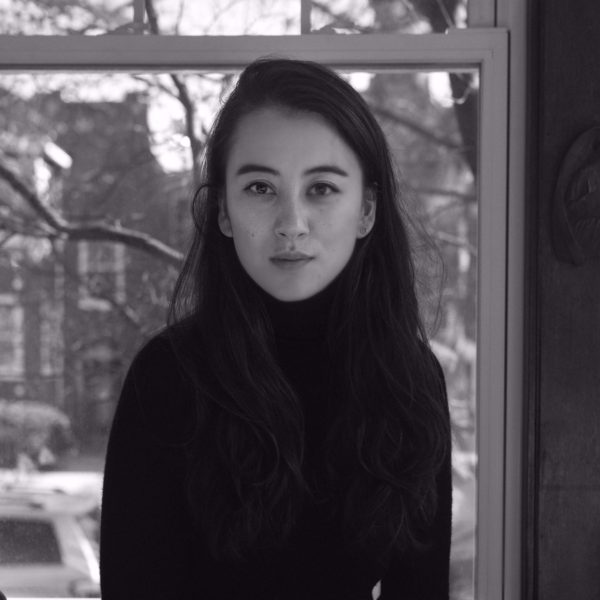
Image by A Befendo/Unsplash, Public Domain Dedication (CC0).
The Mundane Beauty of Home Far Away
There is an intersection in Cambridge that I visit when I feel particularly homesick. It is one of the main thoroughfares in Harvard Square, a scramble-type crosswalk where four different lights turn green at once. On one corner is the Curious George store, on another there is a squat newsstand next to the maw-like entrance of the subway, an escalator marching like a row of teeth into the tongue of the underground. While people rush busily to and fro, I stand carefully on the newsstand side, waiting at the lip of the curb for the light to turn. It flashes green, and I half-close my eyes. The sound fills the intersection: pi-po, pi-po, pi-po.
This is my homesickness antidote: the sound of the crosswalk. It’s so mundane that it’s silly, this signal playing to alert those who are visually impaired that they may cross the street. Apparently the sound is called an Audible Pedestrian Signal. It differs from city to city, intersection by intersection, corner by corner. A couple blocks away, the intersection erupts into what sounds like an insistent snare drum; at another, the cuckoo-like signal is slightly out of tune, warping the imprecise interval at every utterance. But at that particular intersection, on that particular street, the Audible Pedestrian Signal sounds exactly like the ones of my Japanese hometown, and something about its lolloping blooping brings me comfort.
When I am homesick for Japan, I am homesick for small crosswalks and the sound of the neighborhood convenience store’s door sliding open with a ping. I long for the badly lit coffee shops I frequented with my grandfather as a child, a thick slab of shoku-pan glazed in salty butter, the non-smoking section designated half-heartedly, feline cigarette smoke curling into every booth. I yearn for amorphous things, things hard to articulate. Sometimes I will walk through a particular patch of street, and I will smell a mix of grass, dirt, sewer gas, and steam and call to my sister ahead of me that if she stands exactly where I am standing, she will smell early morning in front of our Baba’s house. More often than not, my sister retraces her steps and plants herself next to me, sniffing. “You’re right,” she’ll say, breathing deep.
For me, Takahata Isao’s movies are like that: a wide, chest-aching inhalation of home. Especially since learning of his death last month (a surreal experience, jarring my illogical confidence that animation giants like himself or Miyazaki Hayao were infallible and immortal), I’ve been thinking particularly about Studio Ghibli’s Hohokekkyo! Tonari no Yamadakun, or My Neighbors The Yamadas, which Takahata wrote and directed. Released in 1999, the film is based on a comic strip called Nonochan and follows the Yamada family in the fictional city of Tamanono. The Yamada family consists of a mother and father, Yamada Matsuko and Takashi, an older brother named Noboru, a younger sister named Nonoko, their grandmother Shige and dog Pochi. Concerned with the hilarity and the poignancy of daily life, Yamadakun is a departure from the usual sweeping epic characteristic of Studio Ghibli films and is comprised entirely of domestic vignettes. In one episode, the family forgets Nonoko at a shopping center. In another episode, mother Matsuko remarks to herself that she made curry rice for dinner yesterday and the day before that. Around the corner, we see Nonoko and Noboru waiting with bated breath for their mother to declare she’ll make something different for dinner. Matsuko looks up from the kitchen table and determinedly exclaims, “It’s settled! Today for dinner I’ll make…” — Nonoko and Noboru stretch toward the kitchen door — Matsuko concludes, “curry rice again!” Dejected, Nonoko and Noboru slump to the floor.
The film does not limit itself to humor, but tackles the sadnesses of everyday life. In a vignette occurring outside the family home, grandmother Shige visits a friend at the hospital. The friend cheerily shows Shige around, pointing out a favored vending machine, exclaiming that the food in the cafeteria is not so bad. Eventually, the tour ends with the friend and Shige on the roof of the hospital, ostensibly to admire the view, when the friend’s smile falters. She confesses to Shige that she is seriously ill. The smile on Shige’s face slackens, the points of her mouth crumpling downward as her friend’s laughter dies into a sob. Even this lag in facial expression, portraying the oft-confusing elasticity of emotion, feels painfully real, a subtle depiction of the banality of grief.
Though Yamadakun was released exactly a year before my family moved permanently from Japan to the United States, our family copy of the film was bought off the sale rack of a local video store several years later on one of our semi-annual trips home, one of many frantic purchases before going back to the United States to try to prolong the feeling of being in Japan. Once we were back in the U.S., we would wake up jetlagged at 2 a.m. and shuffle downstairs to watch Yamadakun on repeat. All these stories of regular Japanese life, even Takahata’s depiction of the lobby in the grocery store in Tamanono city, felt like permission to linger a while longer; dwelling in memories of the bumpy textured stairs climbing up from the train station; kneeling in my grandmother’s room to eat dinner; scooping seeds out of sticky slices of watermelon while talking about inane things with my cousins and grandfather. Months later, when the jet lag had worn off and our time in Japan seemed far away, My Neighbor the Yamadas was a touchstone for memory. Takahata Isao’s domestic tableau of the Yamada family was a salve for my sadness; a way to stay in the warmth of our Japanese home, even having left it already. His mastery in depicting the ordinary world gave me a lifeline to the remembrance of those I missed and loved.
It would be an exaggeration, however, to say that Takahata worked only in the medium of the mundane — he also worked in the fantastical and foreign. Before co-founding Studio Ghibli along with Miyazaki, Takahata first worked as a director at Japanese animation juggernaut Toei Animation. At Toei, he was responsible for such fundamentally important animes as Arupusu no Shojo, Heidi (Heidi, Girl of the Alps), and Akage no An (Anne of Green Gables). Takahata storyboarded an episode for the beloved yokai anime Ge ge ge no Kitarou, and is even rumored to have been the person who sold studio executives on Fujiko S. Fujio’s now globally adored classic about a robot cat from the future, Doraemon. Takahata founded Studio Ghibli with Hayao Miyazaki in 1985 and directed his first feature in 1988: Hotaru no Haka (Grave of Fireflies), a heart rending story that follows the relationship between a young brother and sister during World War II, partially inspired by Takahata’s own experiences of bombings as a child in Okayama. At Studio Ghibli, he went on to direct Heisei Tanuki Gassen Pompoko (Pom Poko), Omoihide Poro Poro (Only Yesterday), and of course Hohokekkyo Tonari no Yamadakun (My Neighbors The Yamadas).
A memory surfaces: I am visiting my grandfather in the U.S. who is pushing me on the swings in a high-wide arc. I am singing the song Heidi sings to her grandfather in Arupusu no Shojo with every decibel my five year old lungs can muster while my toes skim the outstretched boughs of a nearby tree. Another memory: It is Thursday evening, 7 p.m., and I am fresh out of the bath, damply lined up next to my sister in my jiji’s room on the tatami-mat floor. We are waiting for the Doraemon theme song to play, signaling our once-a-week television pleasure. If we are lucky, our mother will let us stay up a bit later to watch Kurayon Shin-chan. When I say I am homesick for the mundane, I also mean that I am homesick for mundane culture. While there is a time and place for award winning feature-length films, Takahata’s involvement in the thirty-minute episodes that defined my childhood are not lost on me. Of course his Ghibli films so accurately capture the inside of a typical Japanese home on a weekday evening — after all, it was he that shaped so much of the television chatter we adored on those everyday nights.
Takahata Isao’s last film directed for Studio Ghibli was Kaguya-hime no Monogatari, or The Tale of Princess Kaguya, released in 2013 and based on a 10th century Japanese folk tale called Taketori Monogatari, or The Tale of The Bamboo Cutter. Taketori Monogatari begins with a bamboo cutter who happens upon a glowing stalk of bamboo. He cuts it down to discover a tiny baby girl, whom he takes home to his wife to raise as their daughter. The girl, named Kaguya-hime, grows up into an uncommon beauty, attracting a manner of suitors including the emperor himself. And yet, to the chagrin of her parents, Kaguya-hime denies them all. Her parents can’t understand why she won’t choose a good man to marry, and as the suitors persist their courtships, she becomes more and more removed.
Eventually, her adoptive parents begin to notice that Kaguya-hime is acting strangely, gazing up at the night sky and weeping. She admits to them that she is not human but instead from the moon, where she was exiled to Earth to atone for a sin she had committed. Though she has grown to love her parents and does not want to leave, her people from the moon will come to take her home on the next full moon. Kaguya-hime’s adoptive parents do everything they can to keep her from returning, but when the full moon rises, the moon people arrive anyway, taking a weeping Kaguya-hime with them. The story is at once a fable about the hubris of human men trying to claim women, and a poignant meditation on the nature of home, and what it means to leave it.
Depicted in the same watercolor and sketch-like quality of Yamadakun, Takahata’s adaptation of the folk tale was internationally acclaimed, nominated for an Academy Award in the U.S. after its release. And yet, though I am normally someone who jumps at the chance to see any new Takahata or Miyazaki film, especially one so critically praised, I found myself strangely reluctant to see Kaguya-hime no Monogatari. In fact, I was straight up avoiding it.
While The Yamadas touched on grief and poignancy, its familiarity was comforting, not agitating. Kaguya-hime, on the other hand, felt like an premonition, or a reminder of an inevitable departure from the people and places I loved. Once, I found myself in a lush New York speakeasy, drunkenly sobbing into my cocktail while a bartender studiously ignored me, polishing various glasses. I turned to my partner and tried haltingly to explain the anxiety I occasionally felt paralyzed by when faced with the (usually very exciting) prospect of our future together. Sometimes, his background as a white male from the Midwest felt insurmountably incompatible to my own biracial one, not to mention how to juggle our hopes to return home as adults — me to Japan and him to Chicago. Her patted my back and assured me we’d figure out how to live between both places. “It’s like I’m from the moon, and I have to go back,” I hiccuped. He had no idea what I was talking about, but of course I was referencing Kaguya-hime’s plight.
Since childhood, the story of Kaguya-hime felt like a bad premonition, a warning of a time I would have to leave behind remembrances of my family and Japan. Kaguya-hime’s forcible departure from one home (Earth) to another (the moon) resonated with the constant oscillation between Japan and the U.S. I had traversed since childhood; her sadness felt akin to the sadness that spread inside of me during the last week of a stay in Japan. Everything would become imbued with a sheen of ‘last,’ all of a sudden precious and fleeting. In retrospect, it was a week like this that we purchased Yamadakun, trying desperately to stave off the grief of departure we knew would beset us.
So it took me five years before I finally watched Takahata Isao’s last film, mostly spurred by the news of his death earlier in the month. Last week, I sat down in front of my laptop, a mountain of laundry teetering at my side ready to be folded. How novel could the film be, I reasoned, as if to bolster myself. After all, the source material was essentially a familiar bedtime story, not an omen of my own life. I hit play and began to fold a pair of pants. Fifteen minutes later, the laundry pile remained, totally forgotten. I was absorbed by the story, the brisk brush stroke-like lines used to tell the tale. Plot points that had before seemed matter of fact became deeper, flexing subtext into meaning. The audience witnesses the growth of Kaguya-hime, her toddling as an infant and the betrayal of her body in puberty as she grows into an object of desire beyond her control. We see her powerlessness coupled with her deep love for Earth, wondering along with her as she clasps a wriggling grasshopper in her bare hand, letting it go free in the garden.
When Kaguya-hime finally confesses that she is from the moon, she delivers an emotional monologue detailing her realization of why she has come to earth: to live. To run and breathe and exist among the plants and animals, to embrace fully this life she has been given. She laments her inability to fulfill her task, how short and fleeting her time on the planet seemed, how disappointing the desires of men were in harnessing her from her true purpose. When the envoy from the moon descends to take her home, a heavenly maiden quizzically asks why Kaguya-hime should want to stay in a place where she feels such tumultuous feelings. Kaguya-hime begins to defend life on earth passionately, saying the tumult of emotions is worth the pain. But we all know how the story ends — she is spirited back up into the heavens, the moon looming blankly in the night sky.
As I watched the credits roll, the clock face showing a time far past my usual bedtime, I was filled a blossom of aching gratitude. What I had assumed would be an exercise in remembered anxiety was actually a reminder. Kaguya-hime gave me permission to feel my girlhood anxieties of departure while still leaving me with the impression of a missive, a directive of sorts to go out into the world no matter how small or insignificant every day may seem. In the same way that Hohokekkyo! Tonari no Yamadakun was an invocation of home, Kaguya-hime no Monogatari inspired a complicated gratitude for it. In reality, even my homesickness was rosy. It existed as a convenient memory, glossing over the sharp edges and hurt that existed underneath my idealization of home. And yet; even though there is turbulence and imperfection, anxiety and powerlessness, whether that home is a fantasy lunarscape or the low tables and repetitive dinners characteristic of our daily lives, always there is love and imperfect grace.


Share your reflection